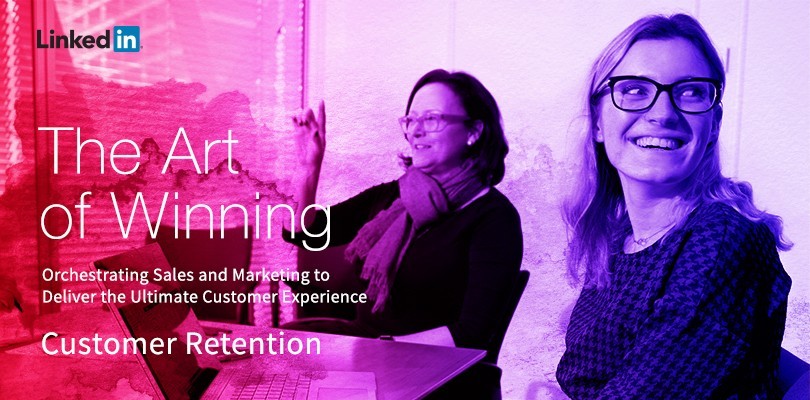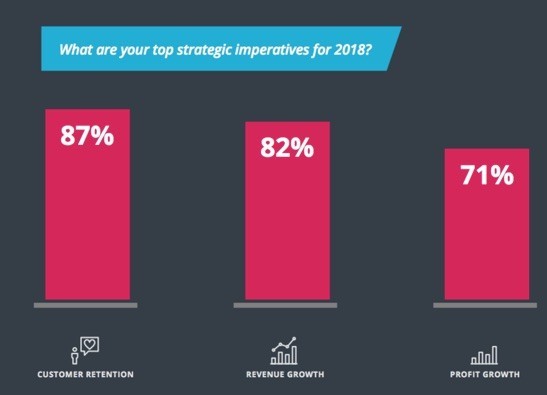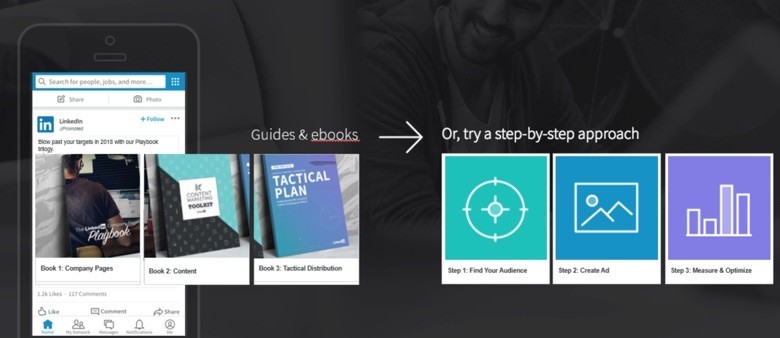Customer Retention: Definition, Strategies and Planning
In 2018, you might think it’s silly to consider an idea that an Italian economist realized in 1906. But, in fact, his insight is directly related to what you’re trying to achieve. Vilfredo Pareto discovered that 80% of the land in Italy was owned by 20% of the population. Known now as the Pareto Principle, this theory about 80/20 distribution holds true all around us.
You’ve likely heard that most companies find 80% of their revenues comes from 20% of their customers. This makes clear the value of retaining customers so you grow their value over time. Customer retention is even more compelling when you consider that acquiring a new customer is anywhere from five to 25 times more expensive than retaining an existing one, depending on the study.
But the value of customer retention isn’t just about saving money. According to research by Frederick Reichheld of Bain & Company (who invented the Net Promoter Score), boosting customer retention rates by 5% boosts profits by 25% to 95%. This leaves one wondering why organizations still focus majority of their time on acquisition, when there’s so much to be gained by providing value throughout the customer lifecycle. Especially when B2B company leaders are prioritizing customer retention in 2018, per an Altify study:
Now it’s just a matter of executing on that belief by getting better at customer retention.
What is customer retention?
Customer retention is the process of executing on a strategy to keep customers from leaving your company. And it is directly tied to the end-to-end customer experience. According to Ewan McIntyre, senior director, analyst, Gartner for Marketers, “The long-term output of any CX [customer experience] program is to create business value. Value is gained through acquiring, retaining and growing profitable customers.”
How customer retention relates to customer marketing
Educating prospects and then customers across their full lifecycle is the key to ensuring smooth, fast product or service adoption and post-sale success. After all, most agree that the leading indicator of customer renewal is a successful adoption experience and product (or service) satisfaction. When companies don’t educate and engage existing customers well enough to help them successfully adopt their offerings, their customers consider other options come renewal time or the next project.
That’s where customer marketing comes in. According to Marketo, customer marketing is “marketing that extends beyond acquiring customers and aims to identify and market additional products or services to existing customers, retain them as customers, and develop them into advocates.” Smart, aligned customer marketing that addresses the entire customer experience leads to customer retention. No wonder 93% of B2B marketers believe that customer marketing will become more important.
According to Dan Miller, EVP of Worldwide Field Sales, Services and Support at Tableau:
“Customer success and its result, customer retention, are the backbone of successful sales and marketing efforts. At Tableau, we’ve recently changed to a subscription model allowing us to base our success on the success of our clients. All of our customer relationships, from demand generation events through customer support calls, should be informed by what enables us to create and keep customers for life.”
Why is customer retention essential?
Retention is the key to driving ongoing profitability and ensuring your company is realizing the biggest ROI on all its customer-related investments. In fact, done well, customer retention efforts not only prevent customer churn, they encourage customer loyalty that translates into follow-on purchases and referrals.
Customer retention is a priority in SaaS businesses
Customer retention is a no-brainer for SaaS, subscription-based businesses that depend on renewals for their survival. Stay too focused on bringing in new customers while ignoring existing ones who are silently slipping away, and a SaaS business could be going under without realizing it. As Laura Ramos, Vice President and Principal Analyst at Forrester Research says:
“ Customer-obsessed marketers know that retaining buyers — and turning them into fans who help advocate for their company’s products and services — is as important as acquiring them in the first place…”
Customer retention drives up profitability
We already mentioned that it’s cheaper to expand business with existing customers than acquire new ones. It’s also easier to sell to existing customers that already know your brand and its offerings. In addition to liking you, they don’t incur the costs associated with switching to a different vendor and solution.
Don’t forget: Many people across your organization invest significant time to convert prospects to customers. And your organization spends a good deal of money in the process. Redirecting that effort to retaining existing customers means your company will be more profitable in the long run.
How to calculate your customer retention rate
To understand how many customers you’re retaining, you need to understand how many you’re losing. You can calculate your churn rate in multiple ways. One option is a revenue churn rate, where you figure out the rate at which you’re losing revenue when customers leave (this is usually reserved for SaaS and subscription-based businesses). Another option is a customer churn rate (CCR) that calculates the rate at which you lose customers over time.
To figure out the latter, choose a period of time for your calculation. Then subtract the number of new customers you acquired from the number of customers at the end of the same period. Divide that number by the number of customers at the beginning of the period. Multiply that answer by 100 to arrive at your customer retention rate (because you ideally want a 100% retention rate).
Gainsight – which offers a Customer Success platform – recommends viewing retention in terms of logos (i.e., companies) to make sure you you’re not overly focused on revenue-based statistics that can cause you to miss weaknesses in your retention strategy. To calculate this, you need to know the:
Number of customers up for renewal (at the beginning of the time period)
Number of renewed logos (at the end of the period)
Then you can use this Customer Retention Calculator from Gainsight to figure out your rate.
Customer retention strategies
Fortunately, you can proactively take steps to boost your customer retention rate. Beyond typical marketing techniques like welcome and win-back campaigns, you can use the following to establish a solid retention program.
Target the right customers from the start
It may seem counterintuitive to be thinking about prospects, but if you aren’t converting the right customers from the start, you are far more likely to experience a retention problem. To that end, be sure everyone in your organization is aligned around the ideal customer profile. Remember: The ideal customer is one that will see the most value from what you offer, while proving most valuable to your company.
Emphasize frictionless, personalized interactions
Since the experience they deliver is what sets top brands apart, make it easy and delightful to do business with your company at every step. Be present where your customers prefer to spend time – across channels, devices, and in person. And make it simple for them to access the information and content they need when they need it.
The good news is that you have a terrific advantage when engaging existing customers because you’ve collected so much data about them. All this data – demographic, firmographic, product usage and more – provides insight into what will resonate most with each customer.
Understand and provide value throughout the customer lifecycle
Embrace the fact that modern marketers and sales professionals are involved in the end-to-end customer experience, with education playing a critical role throughout. Before they become customers, prospects want to understand the value of making a change. In other words, they need to be convinced it’s worthwhile changing their current way of doing things. Once they’re convinced, they want to be sure they should choose your company and its offering as the way to make that change.
Throughout the buyer’s research and purchase process, you supply critical information and content that helps them make an informed, confident and consensus decision. Once a customer is using your product or service, you can provide more information, content, and other educational opportunities that empower the customer to see the best value from their investment. Creating a customer journey map and orchestrating marketing and sales efforts can help in these efforts to align with your customer’s lifecycle.
Expand your reach within an account
Because B2B organizations make purchase decisions through a committee, it’s wise to nurture relationships across that buying team – even after the sale. The goal is to make your product or service indispensable to as many employees and business divisions as possible. Becoming entrenched in this way makes it less likely for the customer to churn. To that end, supply information and content across the committee that paves the way for them to easily onboard colleagues and other team members. A smart way to approach this is through account based marketing, where you personalize engagement with your high-opportunity, high-value accounts.
Adopt a community mindset
One of the reasons why Tableau customers stay customers for life is because of the company’s vibrant community. “The community shares its enthusiasm for Tableau on our forums, at our user groups and with our free product, Tableau Public. At our annual conference this year, more than seventeen thousand data enthusiasts, including users, ambassadors and Zen masters, came together to share their love of data. Our community helps one another succeed and ultimately, that drives customer retention,” explains Dan Miller.
Creating a customer retention plan
With so much revenue at stake, it pays to put as much thought into your customer retention plan as you do your acquisition plan. We’ve outlined some core steps to get you started.
Step 1: Benchmark your current customer retention
Any meaningful plan will outline key goals and measures of success. But you can’t track how well you’re hitting your goals unless you know where you’re starting. Calculate your customer retention rate so you have a baseline to work from.
Step 2: Understand the experience from the customer’s point of view
To identify opportunities to better retain customers, you need to map out the end-to-end experience from their perspective aligned with your internal processes. Doing so, you can pinpoint where customers are dropping off.
Step 3: Figure out why customers are churning
Next you need to understand why you’re struggling to retain customers at those drop-off points. The best way to get to the root cause is by interviewing both existing customers and those that have already churned. While you might be hesitant to highlight the negative when talking to existing and former customers, more often than not, you’ll find they appreciate that you’re taking the time and making the effort to improve their experience.
Step 4: Document a customer retention strategy
Once you understand the reasons you’re losing customers, document a strategy to reverse the trend. Outline new customer engagement opportunities you identified while conducting your research, along with relevant and realistic retention goals. Socialize this strategy across the company, so everyone understands the goals and their role in driving up retention.
Step 5: Equip everyone to succeed
During your research, you likely uncovered process gaps or other areas that need fine-tuning or a complete overhaul. You might need new tools or even new roles. Gather the appropriate stakeholders from across your company to figure out a plan for creating or modifying processes and content, and addressing any other requirements needed to execute on the retention strategy.
Using Linkedin to improve customer retention
You can take advantage of plenty of solutions at Linkedin – for both sales and marketing folks – to improve customer retention:
Use Sponsored Content to reach a targeted group
A terrific way to engage a certain customer segment is with Sponsored Content. Once you’ve analyzed which of your organic posts are resonating most on LinkedIn, you can amplify its reach with Sponsored Content. This helps make sure you are engaging all key stakeholders within your customers’ organizations with a steady stream of relevant content, such as ebooks, white papers, and free trials.
Use Carousel Ads to educate
Carousel for Sponsored Content is a unique and engaging way to educate your customers on the LinkedIn feed. In a single carousel ad, you can feature a swipeable series of up to 10 cards, and you can customize each card. This gives you the flexibility to, for instance, present a few pages of a guide, or walk customers through a step-by-step process visually, which can help aid in tricky adoption processes.
Use LinkedIn Lead Gen Forms to facilitate the content experience
With LinkedIn Lead Gen Forms, you can make it incredibly easy for your customers to access your content. This tool is how customers can access any content behind a gate, but without filling out a lengthy form. Any LinkedIn member clicking on your content offer simply clicks a button, and their LinkedIn profile information instantly populates your landing page form.
Use Sales Navigator to keep track of key stakeholders
To deliver the best possible experience to each individual customer, use Sales Navigator. Through its Notes & Tags feature, you can keep track of what matters most to each customer and where they are in the customer lifecycle. Plus, through the Buyer’s Circle feature within Sales Navigator, you can identify and keep tabs on the full buying committee. In turn, you can better guide all key stakeholders to find value in your product or service and renew when the time comes.
Use LinkedIn Elevate to share helpful information with customers
You can proactively help your customers succeed with your product or service by highlighting ways they can make the most of it. To that end, LinkedIn Elevate empowers your employees to easily share helpful how-to guides and product announcement information with their social networks on LinkedIn, Twitter, Facebook, and Weibo (to name a few).
Now more than ever, it’s wise to prioritize customer retention in your strategies and tactics. Fortunately, it’s simply a matter of rebalancing the equation within your organization and giving retention the attention it deserves. Do so, and your customers will love you for it – and reward you in the form of more business over the long haul.
Learn how to deliver indispensable customer experiences by downloading our eBook, The Art of Winning: Orchestrating Marketing & Sales to Deliver the Ultimate Customer Experience.
Topics: Sales and marketing alignment
Related articles









